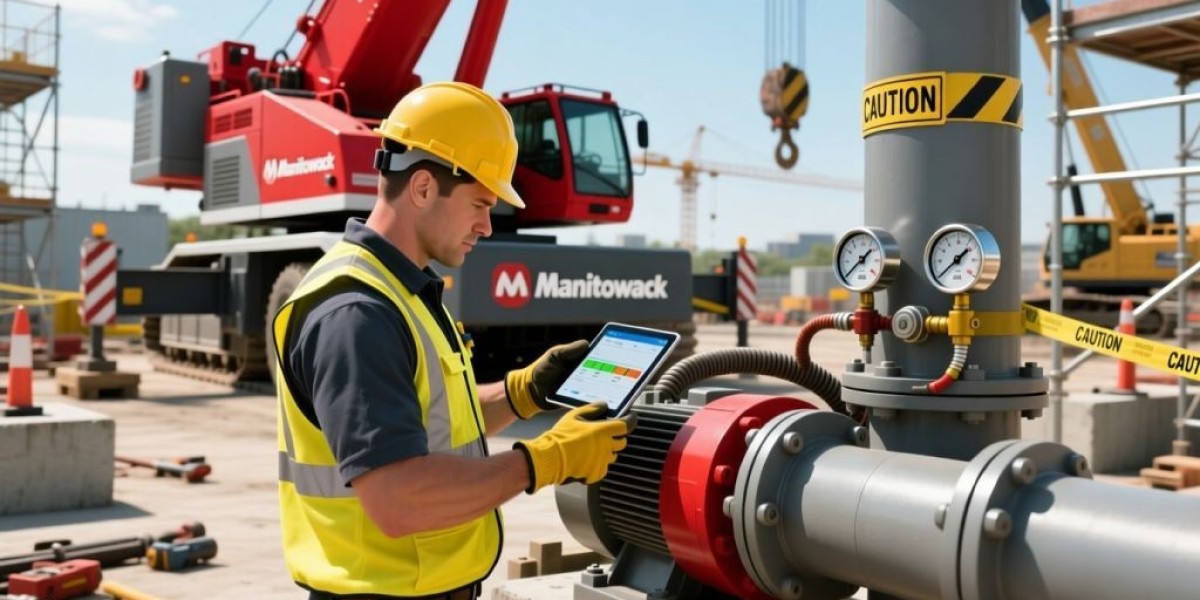For those who operate and maintain heavy lifting equipment, dealing with hydraulic failures in a Manitowoc crane is an inevitable challenge. This guide is specifically designed for technicians, operators, and fleet managers who require a clear, logical pathway to diagnose these complex issues efficiently. The primary objectives are to accurately identify the root cause of the problem, minimize costly machine downtime, and ensure you order the correct Manitowoc crane parts when a replacement is necessary. We will walk through a systematic, practical approach that prioritizes safety and methodical troubleshooting above all else.
Safety First: The Non-Negotiable Starting Point
Always begin by making safety your absolute top priority before initiating any diagnostic work. You must isolate all power sources to the crane and rigorously follow lockout/tagout procedures to prevent accidental activation. Remember that hydraulic fluid under extreme pressure can penetrate the skin, causing severe injection injuries, so wearing appropriate eye protection and heavy-duty gloves is non-negotiable. Furthermore, ensure the crane is on stable, level ground and that any movable components are properly blocked and secured to eliminate any risk of movement while you are working.
The Initial Visual and Sensory Inspection
Your diagnostic process should start with a thorough and simple visual inspection of the entire hydraulic system. Carefully scan for any visible signs of fluid leaks, which may appear as wetness or drips around hoses, fittings, cylinders, and the reservoir itself. Look for obvious issues like loose connections, damaged hose jackets, crimp failures, or pools of oil accumulating on the ground beneath the machine. Also, pay attention to the smell of the hydraulic fluid; a burnt or varnished odor is a strong indicator of systemic overheating and fluid breakdown. These initial visual and olfactory checks can often provide immediate, obvious clues that point directly to the source of the malfunction.
Documenting Symptoms for Accurate Diagnosis
Before you begin disassembling any components, it is crucial to meticulously record all the symptoms and the operating conditions when the failure occurs. Document whether the crane is experiencing a slow degradation in performance, like a gradual loss of lifting height, or a sudden, complete failure of a specific function. Note if particular movements are weak, erratic, or non-responsive, and determine if the issue is isolated to one actuator or if the entire hydraulic system seems sluggish. Also, record any relevant recent events, such as exposure to exceptionally heavy lifts, possible impact incidents, recent maintenance work, or extreme ambient temperatures, as this context is invaluable for narrowing down the list of potential culprits.
Checking Hydraulic Fluid Level and Condition
One of the most fundamental checks involves verifying the hydraulic fluid’s level and assessing its overall condition. A low fluid level in the reservoir is a surprisingly common reason for a hydraulic system to underperform or become noisy, so always check the sight glass or dipstick with the machine on level ground. If you need to top up the system, it is critical to use only the specific grade and type of hydraulic oil recommended by the manufacturer to maintain proper viscosity and lubrication properties. Using an incorrect or substandard fluid can lead to increased wear on pumps and valves, potentially causing more significant damage and necessitating the purchase of expensive Manitowoc crane parts.
Inspecting Filters and Breathers for Clogs
Closely examine the physical condition of the hydraulic fluid by taking a small sample; clean, healthy oil should be relatively translucent and have a mild, characteristic hydraulic smell. If the fluid appears dark, murky, or has a milky consistency, this signals serious contamination from particulates or water ingress, which can severely damage sensitive components. When you suspect fluid contamination, you should immediately plan for a professional fluid analysis and consider a complete system flush to prevent further damage. Widespread contamination often clogs small orifices in valves and rapidly wears down pump internals, leading to catastrophic failures that require a full set of replacement Manitowoc crane parts.
Listening to the Pump and Testing System Pressure
Always inspect the hydraulic filters and tank breathers, as these components are vital for maintaining system cleanliness and proper pressure. Clogged suction or return filters will create a significant pressure drop, forcing the bypass valve to open and allowing unfiltered fluid to circulate throughout the system. When you replace these filters, which should be done according to the manual's schedule, cut open the old one and look for an unusual amount of metal particles or debris, which indicates active internal wear. Finding metallic debris means you must quickly identify the failing component before it contaminates the entire system, saving you from a more extensive and costly repair involving many more Manitowoc crane parts.
Isolating Issues in Valves and Actuators
A clogged or dirty breather cap on the hydraulic tank can create a vacuum inside the reservoir during pump operation, severely restricting fluid flow. This vacuum condition leads to cavitation within the pump, a damaging phenomenon where vapor bubbles form and collapse violently, causing erosion and noise. Therefore, you should regularly clean or replace the breather element and ensure the entire tank vent path is clear of any obstructions. This simple, often-overlooked maintenance step can prevent one of the most common causes of premature pump failure, protecting your investment and avoiding unplanned downtime.
Inspecting Hoses, Cylinders, and Seals
Listen carefully to the hydraulic pump during operation, as unusual sounds are often the first heralds of a developing problem. Screeching or whining noises typically indicate pump cavitation, which sounds like marbles are circulating inside the pump, often due to a restricted suction line, a clogged strainer, or a low tank level. A repetitive knocking sound, on the other hand, can point to internal mechanical damage or wear within the pump itself. If you hear such noises, you should immediately shut down the machine to prevent further damage and begin tracing the suction line for air leaks or blockages that could be the root cause.
Advanced Diagnostics: Heat and Contamination Analysis
Accurate pressure testing is an indispensable step for pinpointing the exact location of a hydraulic fault within the system. Use a reliable pressure gauge to measure the output at the main pump and compare it against the specifications listed in the crane’s service manual. Consistently low pressure at the pump outlet can indicate that the pump itself is worn, the main relief valve is stuck open or incorrectly set, or there is an issue with the pump drive coupling. If the pump pressure is normal but the pressure at a specific actuator port is low, the problem is likely downstream, such as a clogged or malfunctioning directional valve, an external leak, or a faulty control element.
Making the Repair Decision: Rebuild or Replace?
Functionally testing the various valves and actuators can help you isolate whether an issue is localized or system-wide. Valves, including directional, pressure, and flow control valves, are responsible for directing and managing the hydraulic power delivered to the cylinders and motors. If you operate each function and note that only one circuit is slow or weak, you should focus your diagnosis on that circuit’s specific directional valve, its associated pressure-reducing valve, or its pilot control circuit. If multiple functions are simultaneously weak, the problem is more likely a common supply issue, such as a failing pump or a main system relief valve.
The Importance of Documentation and Prevention
Conduct a detailed inspection of all hydraulic hoses, fittings, and cylinders, as these components are subject to constant wear and tear. Hoses can sometimes hide internal damage, such as a delamination that causes a partial blockage or an internal collapse that restricts flow, so look for any external signs like kinks, bulges, or abnormally hard or soft spots. A hose that visibly balloons under pressure is dangerously compromised and must be replaced immediately to prevent a sudden, high-pressure rupture. Similarly, check cylinder rods for any scoring, nicks, or signs of bending, as even minor damage to the rod surface will quickly destroy rod seals and allow external leakage.
Conclusion: A Systematic Path to Success
Monitoring for unusual heat patterns and conducting fluid analysis are advanced diagnostic techniques that can reveal hidden problems. Use an infrared temperature gun to scan pumps, valves, and hoses after the crane has been running under a normal load; a component that is significantly hotter than its neighbors often indicates an internal restriction, excessive friction, or a bypassing valve. When you suspect systemic contamination is the issue, taking a fluid sample for a professional laboratory analysis is a highly recommended practice. The resulting report, which details particle counts, water content, and the presence of specific wear metals, provides definitive data to guide your repairs and helps you decide which Manitowoc crane parts need to be replaced.
If all evidence points to a failing hydraulic pump, you must decide between rebuilding the unit or replacing it entirely. A rebuild using a kit can be a cost-effective option, but only if the pump's main housing and shaft are still within serviceable tolerances; this work should always be performed by a reputable shop that adheres to OEM specifications. When ordering a replacement pump, it is absolutely critical to match the exact model number, which can be found on the pump's identification tag, and to provide your crane's serial number to your parts supplier. Working with a trusted supplier ensures you receive a genuine or verified-compatible unit, guaranteeing performance and longevity.
Finally, always document your findings, the repairs performed, and the Manitowoc crane parts used throughout the process. Keep detailed records of pressure readings, photographs of damaged components, and the results of any fluid analysis, as this documentation is invaluable for future troubleshooting and for verifying maintenance history.
By following this methodical process—prioritizing safety, recording symptoms, checking fundamentals, and using data to guide repairs—you can diagnose hydraulic failures effectively, reduce repeat incidents, and ensure your Manitowoc crane remains a reliable and productive asset on the job site.








